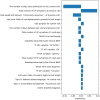Predicting emergency department visits and hospitalizations for patients with heart failure in home healthcare using a time series risk model
- PMID: 37433577
- PMCID: PMC10531127
- DOI: 10.1093/jamia/ocad129
Predicting emergency department visits and hospitalizations for patients with heart failure in home healthcare using a time series risk model
Abstract
Objectives: Little is known about proactive risk assessment concerning emergency department (ED) visits and hospitalizations in patients with heart failure (HF) who receive home healthcare (HHC) services. This study developed a time series risk model for predicting ED visits and hospitalizations in patients with HF using longitudinal electronic health record data. We also explored which data sources yield the best-performing models over various time windows.
Materials and methods: We used data collected from 9362 patients from a large HHC agency. We iteratively developed risk models using both structured (eg, standard assessment tools, vital signs, visit characteristics) and unstructured data (eg, clinical notes). Seven specific sets of variables included: (1) the Outcome and Assessment Information Set, (2) vital signs, (3) visit characteristics, (4) rule-based natural language processing-derived variables, (5) term frequency-inverse document frequency variables, (6) Bio-Clinical Bidirectional Encoder Representations from Transformers variables, and (7) topic modeling. Risk models were developed for 18 time windows (1-15, 30, 45, and 60 days) before an ED visit or hospitalization. Risk prediction performances were compared using recall, precision, accuracy, F1, and area under the receiver operating curve (AUC).
Results: The best-performing model was built using a combination of all 7 sets of variables and the time window of 4 days before an ED visit or hospitalization (AUC = 0.89 and F1 = 0.69).
Discussion and conclusion: This prediction model suggests that HHC clinicians can identify patients with HF at risk for visiting the ED or hospitalization within 4 days before the event, allowing for earlier targeted interventions.
Keywords: electronic health records; heart failure; home care services; machine learning; natural language processing; nursing informatics.
© The Author(s) 2023. Published by Oxford University Press on behalf of the American Medical Informatics Association. All rights reserved. For permissions, please email: journals.permissions@oup.com.
Conflict of interest statement
None declared.
Figures





Similar articles
-
Developing a clinical decision support framework for integrating predictive models into routine nursing practices in home health care for patients with heart failure.J Nurs Scholarsh. 2025 Jan;57(1):165-177. doi: 10.1111/jnu.13030. Epub 2024 Nov 7. J Nurs Scholarsh. 2025. PMID: 39508345 Free PMC article.
-
Clinical notes: An untapped opportunity for improving risk prediction for hospitalization and emergency department visit during home health care.J Biomed Inform. 2022 Apr;128:104039. doi: 10.1016/j.jbi.2022.104039. Epub 2022 Feb 26. J Biomed Inform. 2022. PMID: 35231649 Free PMC article.
-
Detecting Language Associated With Home Healthcare Patient's Risk for Hospitalization and Emergency Department Visit.Nurs Res. 2022 Jul-Aug 01;71(4):285-294. doi: 10.1097/NNR.0000000000000586. Epub 2022 Feb 16. Nurs Res. 2022. PMID: 35171126 Free PMC article.
-
A Machine Learning Approach to Predicting Need for Hospitalization for Pediatric Asthma Exacerbation at the Time of Emergency Department Triage.Acad Emerg Med. 2018 Dec;25(12):1463-1470. doi: 10.1111/acem.13655. Epub 2018 Nov 29. Acad Emerg Med. 2018. PMID: 30382605
-
Machine learning applied to electronic health record data in home healthcare: A scoping review.Int J Med Inform. 2023 Feb;170:104978. doi: 10.1016/j.ijmedinf.2022.104978. Epub 2022 Dec 30. Int J Med Inform. 2023. PMID: 36592572 Free PMC article.
Cited by
-
The Role of Large Language Models in Transforming Emergency Medicine: Scoping Review.JMIR Med Inform. 2024 May 10;12:e53787. doi: 10.2196/53787. JMIR Med Inform. 2024. PMID: 38728687 Free PMC article.
-
The Growing Impact of Natural Language Processing in Healthcare and Public Health.Inquiry. 2024 Jan-Dec;61:469580241290095. doi: 10.1177/00469580241290095. Inquiry. 2024. PMID: 39396164 Free PMC article. Review.
-
Healthcare risk stratification model for emergency departments based on drugs, income and comorbidities: the DICER-score.BMC Emerg Med. 2024 Feb 14;24(1):23. doi: 10.1186/s12873-024-00946-7. BMC Emerg Med. 2024. PMID: 38355411 Free PMC article.
-
Evaluating the validity of the nursing statements algorithmically generated based on the International Classifications of Nursing Practice for respiratory nursing care using large language models.J Am Med Inform Assoc. 2024 May 20;31(6):1397-1403. doi: 10.1093/jamia/ocae070. J Am Med Inform Assoc. 2024. PMID: 38630586 Free PMC article.
-
Developing a clinical decision support framework for integrating predictive models into routine nursing practices in home health care for patients with heart failure.J Nurs Scholarsh. 2025 Jan;57(1):165-177. doi: 10.1111/jnu.13030. Epub 2024 Nov 7. J Nurs Scholarsh. 2025. PMID: 39508345 Free PMC article.
References
-
- Bekelman DB, Havranek EP, Becker DM, et al.Symptoms, depression, and quality of life in patients with heart failure. J Card Fail 2007; 13 (8): 643–8. - PubMed
Publication types
MeSH terms
Grants and funding
LinkOut - more resources
Full Text Sources
Medical
Research Materials
Miscellaneous

